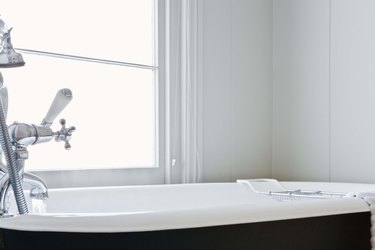
In This Article
Acrylic bathtubs are formed by alternating sheets of acrylic (a nonporous material) with fiberglass (for reinforcement). Unfortunately, although the acrylic-fiberglass layers are durable, the acrylic surface of the tub is a softer material, and it can easily chip or crack. Harsh cleaners can wear away the surface, and things dropped into or banged against the tub can cause chipping. The good news is that repairing chips in an acrylic tub is fairly simple.
Know What's Needed
Video of the Day
A number of kits can be found in any hardware store for this kind of repair. These kits use an epoxy-like filler paste to fill in the chip or crack, sometimes with a clear coat on top to help the paste blend in with the existing tub. Keep in mind that a lot of manufacturers work with repair kit companies to create kits with paste and paint that match the tubs they make. Check the manufacturer's website, and search online for a matching kit.
Video of the Day
In addition to a kit, you'll need a utility knife and probably a selection of sandpaper if there's none included in the repair kit. When using the utility knife, be sure not to risk cutting a finger by using the knife on wet surfaces. Simply allow the tub to dry thoroughly before getting started. And don't forget to open a window to ensure the area is well-ventilated while making the repair.
Repairing the Tub
First, use the utility knife to cut out the damaged area in the shape of a V. This leaves clean edges, which are easier to fill. If the damaged area contains dust or dirt, wipe it out with a damp cloth, or sweep nail polish remover over the area and let it evaporate.
Next, prepare the repair paste according to the directions on the kit. Most kits require you to mix two elements: the paste itself and an initiating agent that will harden the paste as it dries. Mix slightly more than the amount called for so you're prepared in case you need more.
If necessary, use lightening or darkening agents at this point to change the color of the paste to match your tub. Mix thoroughly to ensure all of the paste has been activated.
Finishing the Repair
Pick up some of the paste with the chip or stick included in the mixing kit. If your kit doesn't include one, use a normal caulking knife. Fill in the chip, dent or crack with the paste.
Err on the side of overfilling the area; this leaves excess material that can be sanded down to match the surface of the tub. Follow the manufacturer's instructions on drying time — normally at least an hour.
Once the repair is dry, use wet/dry sandpaper in increasingly fine grits to help blend the repair area with the smooth surface of the tub. Some kits include these materials. Start with sandpaper anywhere from 100 to 250 grit and gently rub the area in a circular motion until the surface of the tub is smooth to the touch. Polish it off with a high-grit wet sandpaper or with the cloth included in the kit. If the kit includes a top coat, apply that once the surface is even.